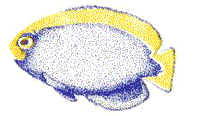-
Browse the Categories to the right, or enter
a topic here
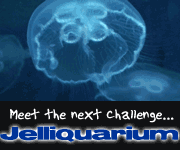
Jellyfish
and Jellyfish Tanks
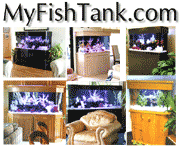
Acrylic Aquariums, Stands, Canopies and
Filters
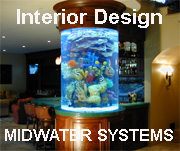
Interior Design Projects

Aquarium Reality Video's
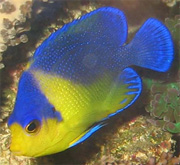
Dwarf and Pygmy Angelfish
Follow us on....





The best and most affordable
Web Host I've ever worked with,...

...and they host this web site.
|
|
|
|
|
|
|
Hard Corals
|
Hard corals are most often referred to as corals that contain a 'hard'
calcium skeleton. Their structure consists of a calcium framework, or base,
of which a polyp or polyps extend off of. These polyps are generally large
( for the sake of this web page they are ), fleshy and consist of one or
more individuals. The fleshy, or bulbous polyps are used for capturing
sunlight, as well as, food particles.
A large number of 'hard' corals contain within the fleshy polyp's)
a symbiotic algae know as Zooxanthellae. This algae lives within the fleshy
tissue and utilizes sunlight via a process called photosynthesis to create
a food source for the coral. One of the by-products of the photosynthetic
process is that the polyp's) will secrete calcium at their base. It's this
depositing of calcium that forms the 'hard' skeleton structure.
In addition to sunlight the coral will also feed on small particles
of living matter, dissolved organics and debris's. Most of these 'hard'
corals have tentacles that are used for capturing these particles. Some
produce the tentacles when they sense food in the water, others only produce
them at night. The tentacle is armed with a nematocyst, or stinging cell,
that is used to sting its prey or to deture encroaching, competitive, corals.
Because of these corals light and food requirements one needs to provide
lighting that is equal to the suns spectrum and intensity ( see
the Lighting page ), taking into consideration the depth and turbidity
at which the coral normally resides, water current parameters, and its
proximity to its neighboring corals.
Purchases of these corals should be subject to inspection of the corals
tissue and its even growth over the edges of the calcium skeleton. These
corals are subject to considerable damage during shipment and handling.
The resulting stress makes them highly subject to protozoan and bacteria
infections.
|
Plerogyra
species
|
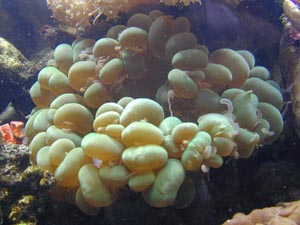
|
Green Bubble Coral,
Plerogyra sinuosa
Bulbous tentacles for capturing sunlight, interspersed with smaller
tentacles for capturing food particles. Most specimens sold in the hobby
were part of a larger colony. |
|
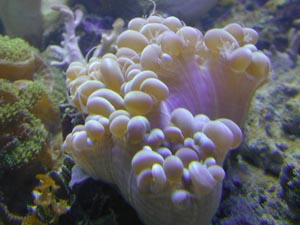
|
White Bubble Coral
Plerogyra sinuosa
Bulbous tentacles for capturing sunlight, interspersed with smaller
tentacles for capturing food particles. Most specimens sold in the hobby
were part of a larger colony. |
|
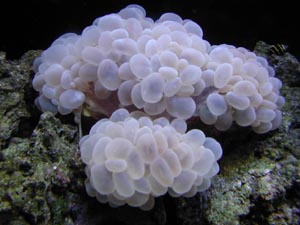
|
Pearl Coral
Plerogyra sinuosa
Bulbous tentacles for capturing sunlight, interspersed with smaller
tentacles for capturing food particles. Most specimens sold in the hobby
were part of a larger colony. |
|
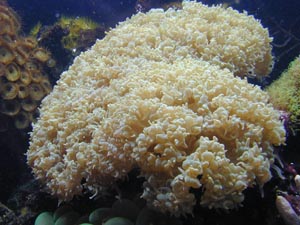
|
Fine Bubble Coral
Plerogyra sinuosa
Bulbous tentacles for capturing sunlight, interspersed with smaller
tentacles for capturing food particles. Most specimens sold in the hobby
were part of a larger colony. |
| Catalaphyllia
species |
|
|
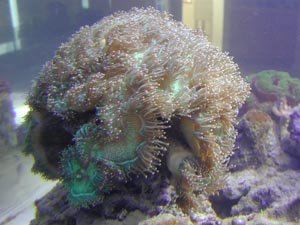
|
Elegance Coral
Catalaphyllia jardinei
Elongated meandering polyps fringed with tentacles. Most often found
in nature partially buried in mud or soft substrates. In general this is
a difficult coral to keep. |
| Euphyllia
species |
|
|
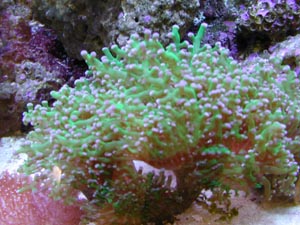
|
Octopus or Frogspawn Coral
Euphyllia divisa
Individual large polyps with elongated tentacles. Tentacles seem to
branch towards their tips. |
|
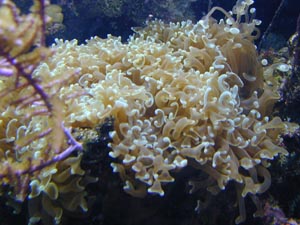
|
Hammer Coral
Euphyllia Ancora
Individual large polyps with elongated tentacles. Tentacles tips have
a slight 'C' or anchor shape to them. |
|
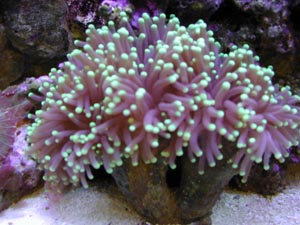
|
Torch Coral
Euphyllia glabrescens
Individual large polyps with elongated tentacles. Tentacles are generally
straight with a bulbous tip. |
| Brain
Corals |
|
|
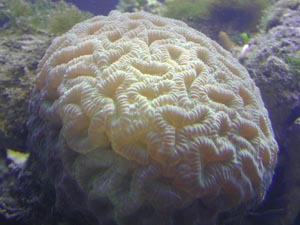
|
Closed Brain Coral
Favia sp.
Individual polyps forming colonies that are dome or flat shaped. Polyps
consist of a central mouth surrounded by a fleshy ring. During feeding
numerous tentacles appear around the central mouth. |
|
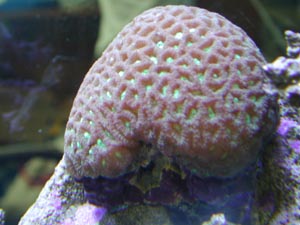
|
Closed Brain Coral
Favia sp.
Individual polyps forming colonies that are dome or flat shaped. Polyps
consist of a central mouth surrounded by a fleshy ring. During feeding
numerous tentacles appear around the central mouth. |
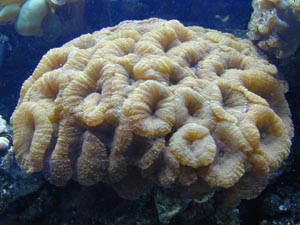 |
Closed Brain Coral
Favia sp.
Individual polyps forming colonies that are dome or flat shaped. Polyps
consist of a central mouth surrounded by a fleshy ring. During feeding
numerous tentacles appear around the central mouth. |
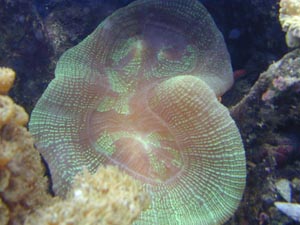 |
Open Brain, or Meat Polyp
Trachyphyllia Geoffrey
Large, open, fleshy polyp with a wide border. Skeleton is cone shaped.
Generally found growing on large gravel bottoms |
|
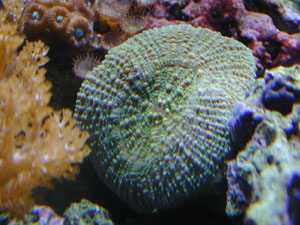
|
Spiny Brain Coral
Symphyllia valenciennesi
Fleshy outer margin ( which covers a sharp coral skeleton ) |
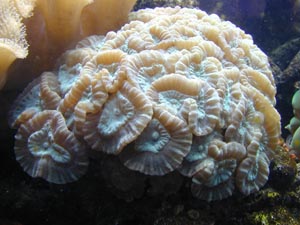 |
Trumpet Coral
Caulastrea furcata
Individual branching polyps forming colonies. Central polyp is surrounded
by a fleshy ring to capture sunlight |
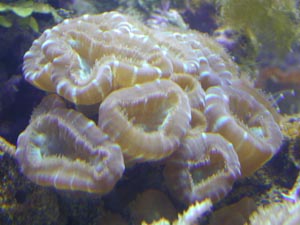 |
Trumpet Coral
Caulastrea furcata
Individual branching polyps forming colonies. Central polyp shown with
tentacles extended |
|
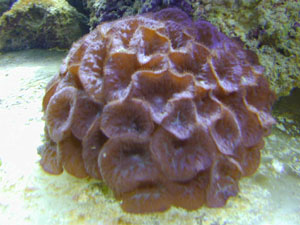
|
Blastomussa
Blastomussa wellsi
Appears as individual polyps but in fact they are all connected |
|
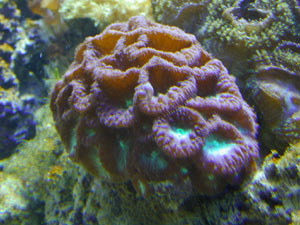
|
Blastomussa
Blastomussa wellsi
Appears as individual polyps but in fact they are all connected |
|
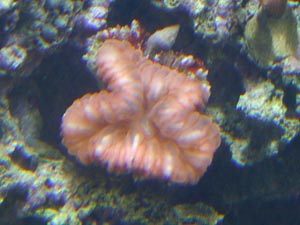
|
Tooth, Molar Coral
Cynarina lacymalis
Pillowy outer margins have a semi-clear tissue that shows the coral
ridges inside |
| Cup Coral |
|
|
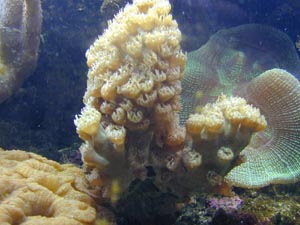
|
Branching Cup, Pogoda Coral
Turbinaria peltata
Skeleton framework is thick and covered with polyps which elongate |
|
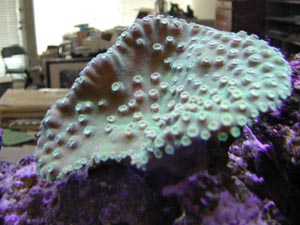
|
Cup, Pogoda Coral
Turbinaria peltata
Skeleton framework is thick and takes on a 'bowl' formation Top, or
disk, is covered with polyps. |
|
Visit the Aquarium Design home page
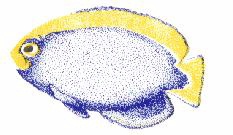
|
|






